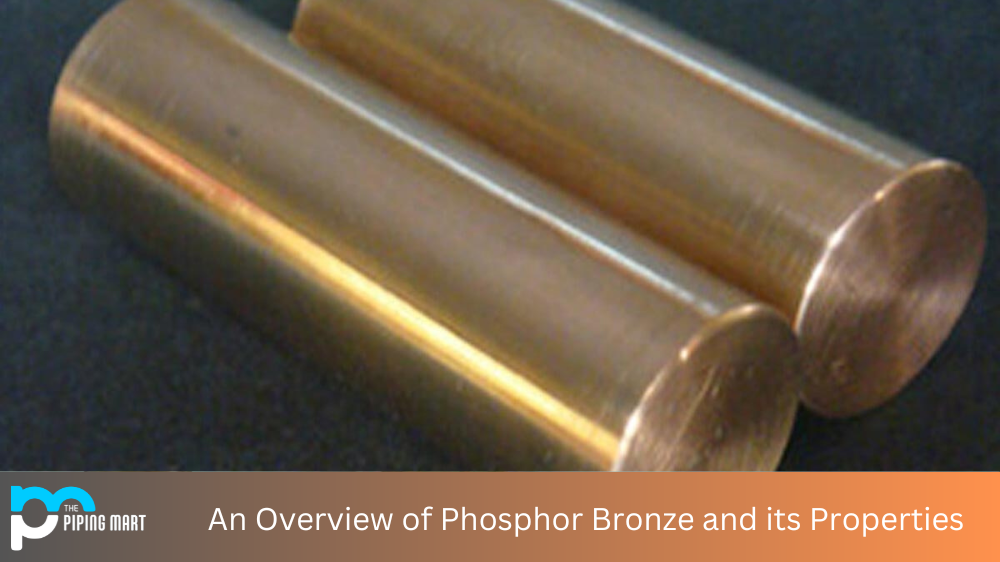Phosphor bronze is an alloy made from copper and tin, with phosphorous added for strength. It’s known for its superior corrosion resistance and is used in many industrial applications. In this blog post, we’ll go over the properties of phosphor bronze, including its machinability, conductivity, hardness, mechanical properties, yield strength, chemical composition, and potential applications.
Machinability
Phosphor bronze has excellent machinability due to its good tensile strength and ductility. This makes it ideal for turning and boring as well as threading operations. Its high thermal conductivity also helps to prevent heat buildup during machining operations. The alloys are usually supplied with good surface finishes requiring minimal grinding or polishing after machining.
Conductivity
The electrical conductivity of phosphor bronze is relatively low compared to other alloys, such as copper or aluminum but still higher than most steel alloys. The presence of tin in the alloy gives it very good corrosion resistance, which makes it ideal for electrical applications in harsh environments like marine environments or near-shore industrial facilities. It is also non-magnetic, which makes it suitable for use in electrical components that need to be shielded from magnetic fields, such as motors and generators.
Hardness
The hardness of phosphor bronze varies depending on the alloy composition but generally ranges from 30-50 Rockwell C (Rc). This range makes it suitable for wear-resistant parts for bearings and bushings and gears and pinions where shock loading may occur. It also offers improved fatigue resistance over other metals, making it well-suited for high-cycle applications such as springs or fasteners subjected to repeated cyclic loading conditions.
Mechanical Properties
The mechanical properties of phosphor bronze depend on the amount of copper and tin contained in the alloy as well as any additional elements added during the manufacturing process, such as zinc or lead. Generally speaking, these alloys exhibit very good tensile strength at elevated temperatures up to 150° C (302° F) along with good ductility even at room temperature making them suitable for high-temperature applications such as furnace liners or exhaust manifolds where there is a need for superior dimensional stability under elevated temperatures conditions up to 200° C (392° F).
Yield Strength
The yield strength of phosphor bronze depends on the exact alloy composition but typically falls within a range from 500 MPa (72 ksi) up to 900 MPa (130 ksi). This range makes phosphor bronzes suitable for various load-bearing applications, such as gears with high sheer forces without sacrificing toughness or ductility at elevated temperatures up to 150° C (302° F).
Chemical Composition
Phosphorus bronzes contain approximately 97-99% copper with 1-3% tin by weight and trace amounts of other elements such as lead, zinc, bismuth, or arsenic, depending on their intended application requirements. These additional elements can help improve their physical characteristics while maintaining excellent corrosion resistance due to their high copper content.
Application
Phosphorus bronzes have a wide range of potential applications due to their excellent physical characteristics combined with superior corrosion resistance compared to other alloys such as steel or aluminum alloys making them an ideal choice when looking for materials that will not corrode easily in harsh environments like marine environments or near shore industrial facilities. Their wide range of mechanical characteristics makes them suitable for use in a variety of applications ranging from electrical components like wiring harnesses, switches, connectors, terminals, relays, etc., To wear-resistant parts like bearings, bushings, gears, shafts, pins, etc., To precision machine parts like screws, nuts bolts, etc., To springs & fasteners under repeated cyclic loading conditions.
Conclusion:
Phosphorus bronzes offer a unique combination of excellent physical characteristics and superior corrosion resistance, making them an ideal material choice when looking for materials that can withstand harsh environments without corroding quickly. Their wide range of mechanical properties makes them suitable for use in many different applications ranging from electrical components, wear-resistant parts, precision machine parts & springs & fasteners under repeated cyclic loading conditions. With their ability to provide superior performance even at elevated temperatures up to 150° C (302° F), they are an excellent choice when looking for materials that need superior dimensional stability under extreme temperature conditions. So if you’re looking for materials that combine both durability & performance, then look no further than phosphorus bronzes!

A passionate metal industry expert and blogger. With over 5 years of experience in the field, Palak brings a wealth of knowledge and insight to her writing. Whether discussing the latest trends in the metal industry or sharing tips, she is dedicated to helping others succeed in the metal industry.




